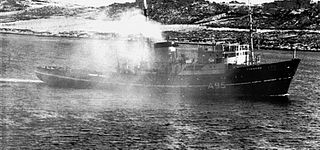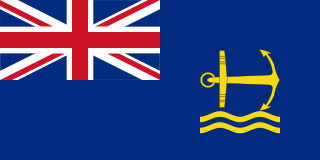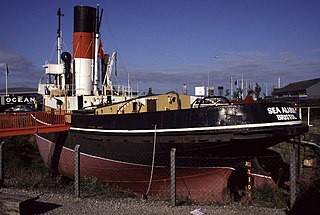
RMAS Typhoon (A95) was an ocean-going tug of the Royal Maritime Auxiliary Service (RMAS). She was designed for ocean towing, rescue, salvage and fire-fighting. She was the first ship to leave the United Kingdom ahead of the task force for the South Atlantic during the 1982 Falklands War. She had a fishery protection role in the Cod Wars.

The Royal Maritime Auxiliary Service(RMAS) was a British Government agency which ran a variety of auxiliary vessels for His Majesty's Naval Service and the Royal Fleet Auxiliary. The service from 2009 has been run by Serco and is known as Serco Marine Services.

His Majesty's Naval Service is the United Kingdom's naval warfare and maritime service. It consists of the Royal Navy, Royal Marines, Royal Fleet Auxiliary, Royal Naval Reserve, Royal Marines Reserve and Naval Careers Service. The term Naval Service should be distinguished from the "UK Naval Services", which consist of the Naval Service and the Merchant Navy. The Naval Service as a whole falls under the command of the Navy Board, which is headed by the First Sea Lord. This position is currently held by Admiral Sir Ben Key. The Defence Council delegates administration of the Naval Service to the Admiralty Board, chaired by the Secretary of State for Defence.

SD Salmoor was a Sal-Class mooring and salvage vessel working at HMNB Clyde, and based at Great Harbour, Greenock. She was originally operated by the Royal Maritime Auxiliary Service, but after the organisations disbandment in March 2008 she was operated by Serco Marine Services.

MT Deerhound is a Dog-class medium berthing tugboat built for the Royal Maritime Auxiliary Service (RMAS) in 1966 by Appledore Shipbuilders, Appledore, North Devon.

The MS Finbo Cargo is a roll-on/roll-off passenger ferry that was previously called the European Endeavour which was owned and operated by P&O Ferries until May 2019. Eckerö Line purchased the ship from P&O in 2019 and is expected to take delivery in June 2019 and renamed her MS Finbo Cargo.
Colonel Templer may refer to:
Nine ships of the Royal Navy have borne the name HMS Milford:

HMS Sir Galahad was a trawler built for the British Royal Navy in 1941. Post war it was sold into civilian service and was wrecked in 1957 after running aground off the Isle of Mull.

Serco Marine Services is a Private Finance Initiative contract, with Serco Group, to deliver auxiliary services to His Majesty's Naval Service.
NI Mário Ruivo, previously known as NI Mar Portugal, is a research vessel of the Portuguese Institute of the Sea and the Atmosphere (IPMA).

RMAS Salmaster (A186) was a Sal-Class mooring and salvage vessel. It came under the Royal Maritime Auxiliary Service department of the Royal Navy, and was sold in 2001.

The Government Service Ensign is a defaced Blue Ensign flown by vessels owned by the British Ministry of Defence for which no other ensign is appropriate. It is most commonly seen flown by warships undergoing contractors' trials before being commissioned into the Royal Navy, and former Royal Maritime Auxiliary Service vessels now operated by Serco Denholm.

Admiralty tugs were tugboats built for and operated by the Royal Navy. These were vessels built to Admiralty specifications and in specific classes during the First and Second World Wars. They were built to meet the Royal Navy's demand for auxiliary vessels and to supplement the civilian tugs requisitioned by the Admiralty for war service.

SD Victoria is a worldwide support ship operated by Serco Marine Services in support of the United Kingdom's Naval Service, and currently the second largest ship operated by Serco Marine Services, after SD Northern River.
Junella was a fishing trawler, best known for her service with the Royal Navy during the Falklands War. She was built in 1975 for J Marr & Son, a Hull-based fishing company. On 11 April 1982 she was taken up from trade by the British government and commissioned into the Royal Navy. She was fitted with Second World War era minesweeping gear at Rosyth Dockyard, manned by Royal Navy sailors and allocated to the 11th Mine Countermeasures Squadron. She sailed on 26 April but was unable to commence sweeping until after the 14 June Argentine surrender. In the meantime she was utilised to transfer troops and stores between ships and landed special forces troops at San Carlos. Demining operations commenced on 21 June. Junella returned to the United Kingdom on 11 August, carrying a defused Argentine mine.
Several ships of the British Royal Navy have borne the name Bustler:

RMAS Newton was an underwater research vessel with limited provision for cable laying. She was originally used for sonar propagation trials.












